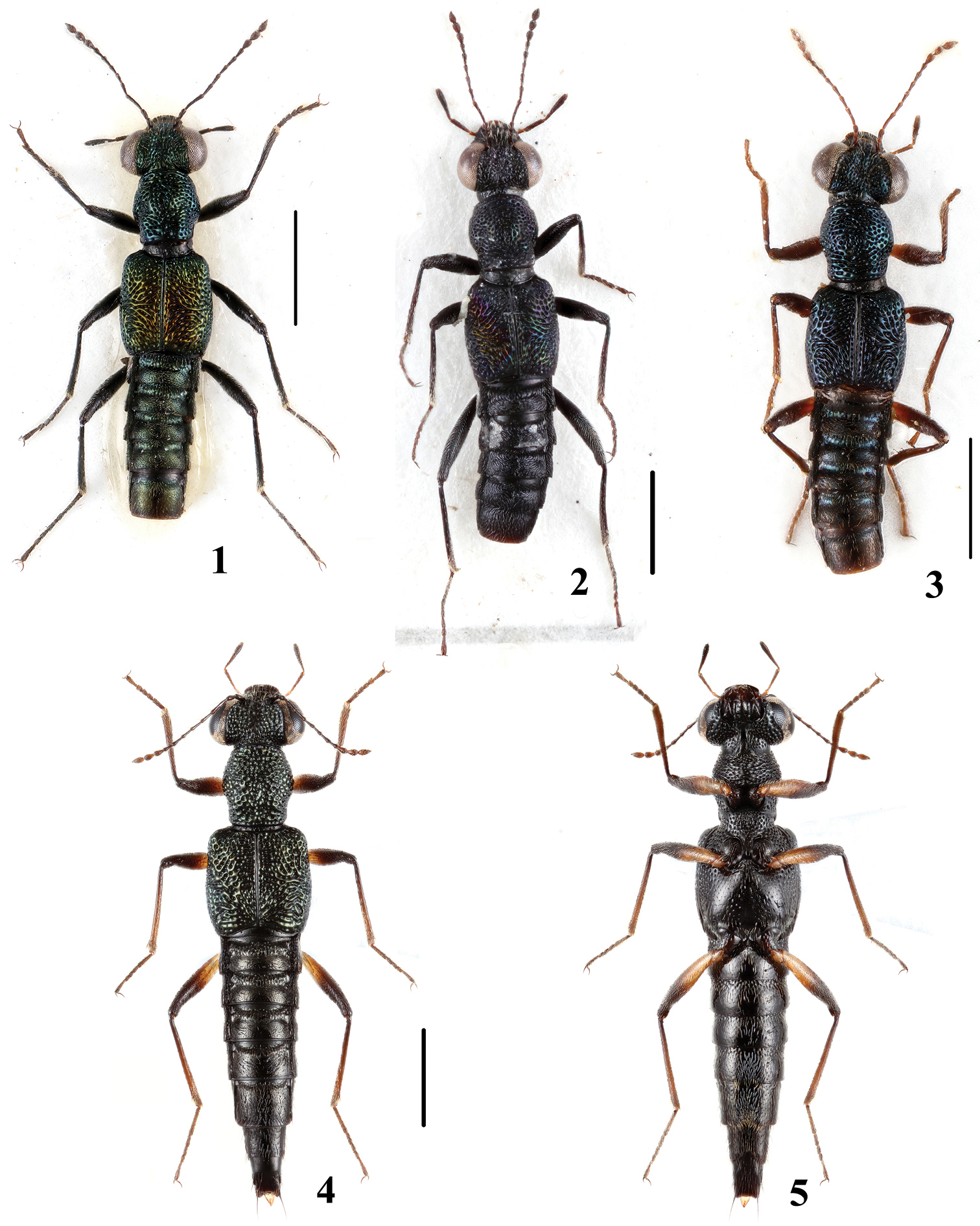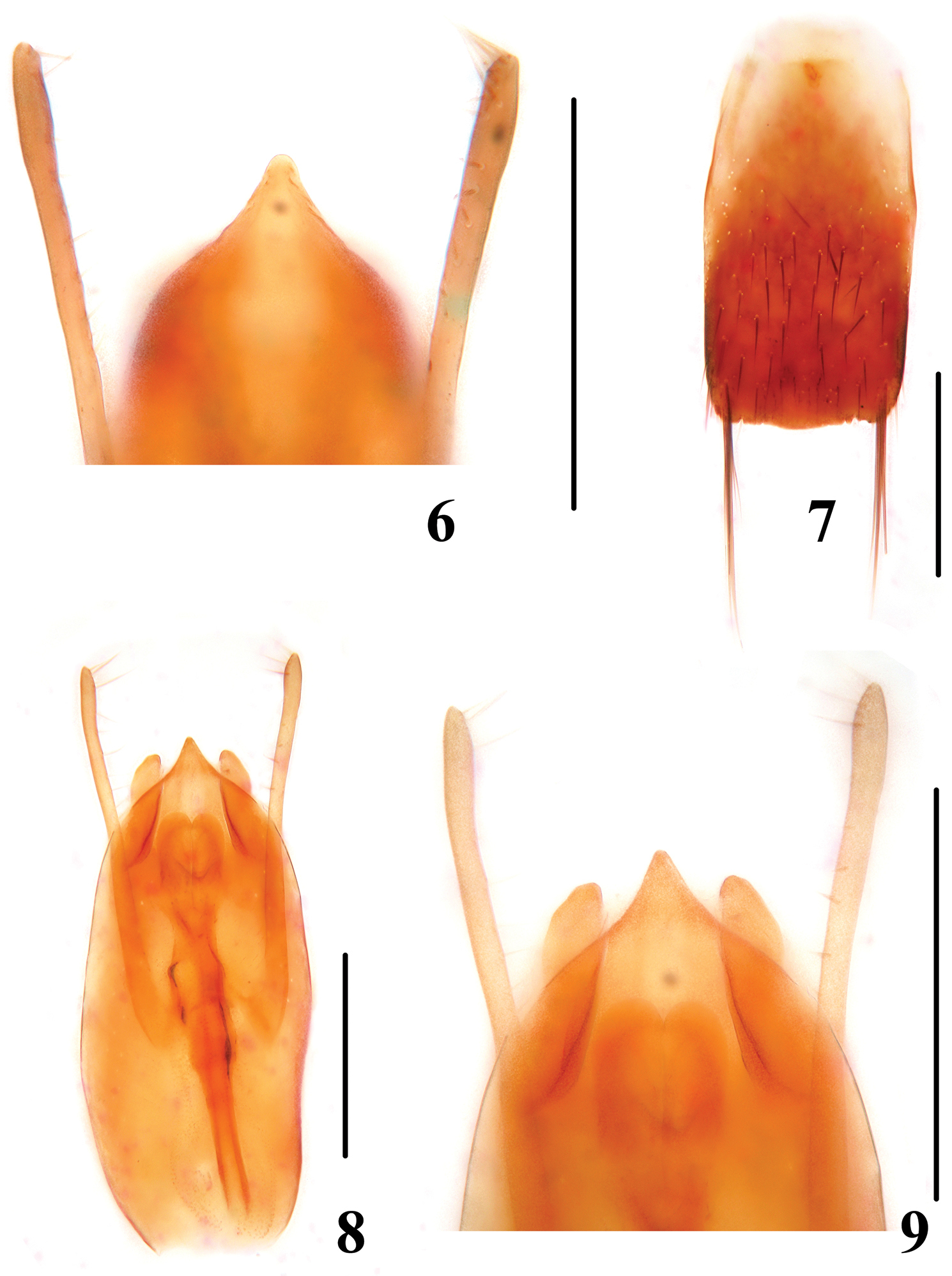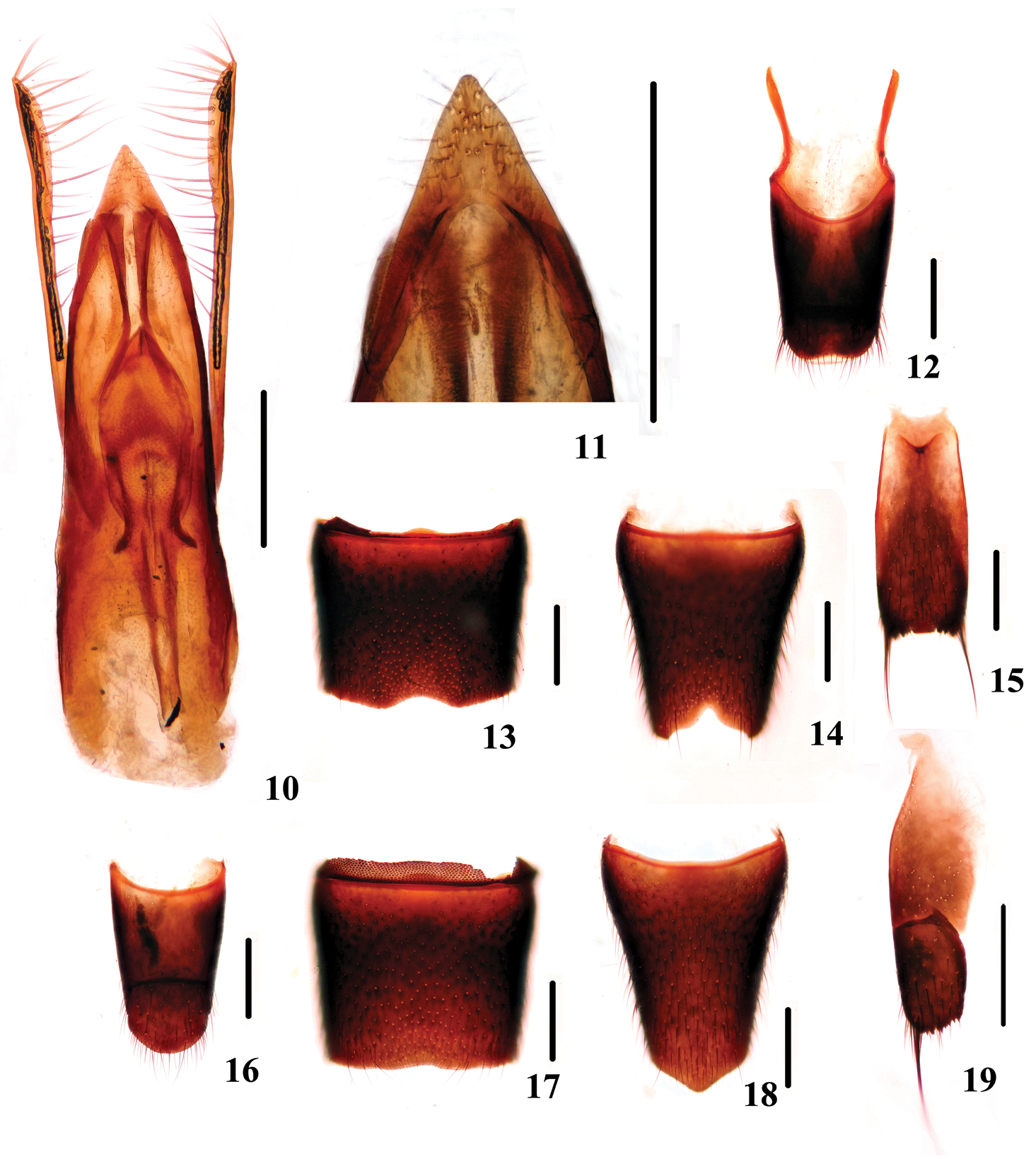






(C) 2013 Liang Tang. This is an open access article distributed under the terms of the Creative Commons Attribution License 3.0 (CC-BY), which permits unrestricted use, distribution, and reproduction in any medium, provided the original author and source are credited.
For reference, use of the paginated PDF or printed version of this article is recommended.
Citation: Tang L, Li L-Z (2013) Notes on the Chinese species of Dianous group I (Coleoptera, Staphylinidae). ZooKeys 342: 13–19. doi: 10.3897/zookeys.342.5842
Dianous zhujianqingi Tang & Li, 2011 syn. n. is synonymised with Dianous cyaneovirens (Cameron, 1930). Additional records of Dianous yao Rougemont, 1981, Dianous haraldi Puthz, 2000 and Dianous huanghaoi Tang & Li, 2011 are provided.
Coleoptera, Staphylinidae, Dianous, new synonym, new records
The Chinese species of Dianous group I were reviewed by Tang and Li in
For examination of the male genitalia, the last three abdominal segments were detached from the body after softening in hot water. The aedeagus and other dissected parts were mounted in Euparal (Chroma Gesellschaft Schmidt, Koengen, Germany) on plastic slides. Photos of sexual characters were taken with a Canon G7 attached to an Olympus SZX 16 stereoscope; habitus photos were taken with a Canon macro photo lens MP-E 65 mm attached to a Canon EOS40D camera.
The type specimens treated in this study are deposited in the following public and private collections:
cSme private collection Aleš Smetana, Ottawa, Canada
NHMW Naturhistorisches Museum Wien, Austria (Harald Schillhammer)
SNUC Department of Biology, Shanghai Normal University, P. R. China (Li-Zhen Li)
http://species-id.net/wiki/Dianous_cyaneovirens
Figs 1, 2, 6China: Jiangxi, Guizhou: Type series of Dianous zhujianqingi (SNUC); Guangxi: 1♂, Jinxiu County, 16 km, 900m, 29.VII.2011, Peng Zhong leg.; 1♀, Jinxiu County, Shengtangshan, 800–1100m, 28.VII.2011, Peng Zhong leg. (SNUC); Yunnan: 6♂♂14♀♀, Baoshan City, Baihualing, 1100-1350m, 25°16'N, 98°47'E, 22.IV. 2013, Song, Dai & Peng leg. (SNUC); Myanmar: 1♂1♀, Kachin State, ca. 12 km S Putao, W Mularshidi Vill., 500–550m, 27°14.98'N, 97°24.40'E, 2.VI.1999, Schillhammer & Schuh leg. (NHMW); Nepal: 1♂2♀♀, Khandbari Dis., Arun Valley at Num main bridge, 1000m, 21.IV.1984, Smetana & Löbl leg. (cSme); 1♂, Khandbari Dis., Induwa Khola Valley, 2000m, 15.IV.84, Smetana & Löbl leg. (cSme)
China (Jiangxi, Guizhou, Guangxi, Yunnan), Myanmar, Nepal.
The species is reported from the Chinese provinces Yunnan and Guangxi and from Myanmar for the first time. According to the original description of Dianous zhujianqingi, the main differences between this species and Dianous cyaneovirens are the different coloration and different lengths of the apical portion of the median lobe. Additionally, there was a huge distributional gap between Nepal and East China. However, with more material examined, this distribution gap is filled. The coloration of the species is found to be greatly variable: in the Nepalese populations, the metallic tint of the species varies from golden green to blackish blue, while it is golden green or blue in specimens from Myanmar and China (Guangxi and Yunnan). In the type series of Dianous zhujianqingi, all 39 specimens have a faint plumb-coloured tint, except for two specimens from Jiangxi which have a strong brassy tint. The length of the apical portion of the median lobe is also variable: the length is intermediate in specimens from Myanmar and China (Yunnan and Guangxi). For these reasons, Dianous zhujianqingi is synonymised with Dianous cyaneovirens.
Habitus of Dianous. 1 Dianous cyaneovirens (Myanmar) 2 Dianous cyaneovirens (Nepal) 3 D. haraldi 4, 5 Dianous yao. Scales = 1 mm.
6 apical portion of median lobe of Dianous cyaneovirens (Myanmar) 7–9 Dianous haraldi: 7 male sternite IX 8 aedeagus 9 apical portion of median lobe. Scales = 0.25 mm.
http://species-id.net/wiki/Dianous_haraldi
Figs 3, 7–9China: Yunnan: 1♂, Xishuangbanna, ca. 6km NW Mengla, 700m, 8.VIII.1999, Jäch et al. leg. (CWBS 356) (NHMW)
China (Yunnan), Laos.
The species is a new record for China
To accommodate Dianous haraldi, the recently published key to the Chinese species of Dianous group I (Tang, Li and Cao 2012) is modified at couplet 6 as follows:
| 6 | Forebody black with plumb-coloured lustre, sometimes elytra with brassy reflection; femora unicolored | 7 |
| – | Forebody distinctly metallic blue; femora bicolored | 7a |
| 7a | Punctation of elytra more confluent; posterior margin of male sternite VII with indistinct median emargination. Habitus (Fig. 3), aedeagus (Fig. 8, 9) | Dianous haraldi |
| – | Punctation of elytra less confluent; posterior margin of male sternite VII with deep median emargination | 8 |
http://species-id.net/wiki/Dianous_huanghaoi
China: Yunnan: 1♂, Binchuan County, Jizushan, 2400m, 18.VII.2010, Tang leg. (SNUC)
China (Yunnan).
Previously, the species was only known from Yulongshan and Hutiaoxia in Yunnan.
http://species-id.net/wiki/Dianous_yao
Figs 4, 5, 10–19China: Yunnan: 35♂♂31♀♀, Baoshan City, Baihualing, 1100-1350m, 25°16'N, 98°47'E, 22.IV. 2013, Song, Dai & Peng leg. (SNUC)
China (Guizhou, Yunnan); Myanmar, Thailand.
The species is new to the Chinese province Yunnan.
Sexual characters of Dianous yao. 10 aedeagus 11 apical portion of median lobe 12 tergites IX uand X 13 male sternite VII 14 male sternite VIII 15 male sternite IX 16 female tergites IX and X 17 female sternite VII 18 female sternite VIII 15 valvifer. Scales = 0.25 mm.
We would like to express our sincere gratitude to Dr. V. Puthz (Germany) for his kind guidance on our study, to Dr. A. Smetana and Dr. H. Schillhammer for the loan of material, and to all the collectors mentioned in the paper. The research was supported by the National Natural Science Foundation of China (No. 31101659 and No. 31172134), the National Natural Science Foundation of Shanghai (No. 10ZR1421600) and the Innovation Program of Shanghai Municipal Education Commission (No. 12YZ077).


